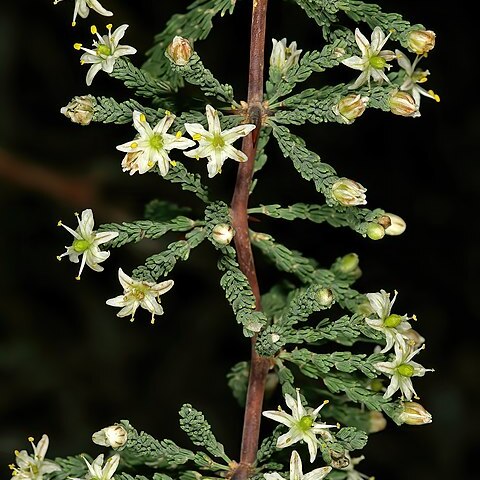Small, dense, hard, spiny shrubs up to 1 m high, very variable. Rhizome compact, with many terete, hard roots ±6 mm in diameter. Stems several, erect, somewhat zigzagging, spine-tipped, with the branches spreading or contracted ('fox-tail' form). Spines cauline in origin, usually 3-nate, with the central longest, straight or recurved, ±30 mm long; the laterals short or also developing into branches or repressed. Branchlets bearing cladodes in the second year, aspinous, in short fascicles on both sides of the multibudded axils. Cladodes usually 13 cm overlapping compact fascicles, narrowly obovoid, 2-5 mm long or, in var. litoralis, globose, ±1 mm, or reduced to some small appressed bracts, pubescent or rarely glabrous, surrounded by a membranous, ciliate bract at base. Flowers apical, sessile, placed on a disc, solitary or binate, enveloped by an open, 3-lobed, ciliate, membranous bract; tepals puberulous dorsally, 3-5 mm long, with a green or purple centre streak. Stamens with flattened filaments; anthers yellow. Ovary with 4(6-) ovules in upper part, obovoid; style short with 3 short stigmas. Berry usually 1-seeded, ±4 mm in diameter, red, perianth persistent at the base.
More
Erect, dense, spiny shrub, up to 0.5 m tall, stems brush-like, spines in threes, the central longest. Cladodes mostly 5 in clusters, sublinear, hairy or rarely smooth. Flow ers 1 or 2, sessile, on an apical disc, tepals and filaments spreading. Mainly Apr.-Aug.
Erect spiny shrub to 1 m, stems brush-like, with spines in threes. Cladodes mostly 5 in clusters, sublinear, hairy. Flowers 1 or 2 on an apical disc, tepals and filaments spreading.
A dense thorny shrub. It grows 1 m tall. The leaves are small and spiny. The flowers are very small and white. They have a scent.

